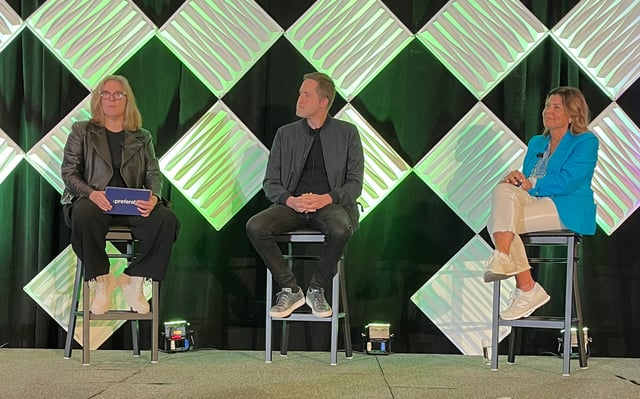How Kroger and Instacart Build Ideal Shopper Experiences
Grocery retailers are gaining in their competitive market position, based on their ability to deliver experiential shopping experiences. According to The Kroger Co. and Instacart at Progressive Grocer and RIS’ recent GroceryTech event, held this past July 12-14 in Cincinnati, that means inspired, personalized experiences across e-commerce and physical channels.
Going from Omnichannel to Seamless
“What we’re seeing is a consumer demand for taking the things they love online – convenience and personalization – and bringing it to the store to create a seamless, unified experience,” said David McIntosh, VP and GM of connected stores at San Francisco-based Instacart during a July 13 GroceryTech session, “Creating Next-Gen Customer Experiences.”
Customers have expected their shopping journey to be unified in an omnichannel way for some time. Now they’re expecting those experiences to be delivered seamlessly, with a personalized touch.
“Omnichannel is bringing multiple channels together so that customers can shop both online and in store, but that’s very functional,” noted Jody Kalmbach, Group VP, product experience at Cincinnati-based Kroger, at the same session. “Seamless is about how you make people feel.”
Continued Kalmbach, “Seamless is giving customers what they want, when and how they need it, removing friction.”
Removing Friction Is Critical
Kroger is removing friction by giving store associates the digital tools to do their jobs. These solutions are eliminating repetitive tasks and allowing associates to engage more with customers.
[Read more: "EXCLUSIVE: Kroger Builds a Workforce for the Future of Grocery"]
Core to Instacart’s strategy of removing friction is its Caper Cart, an AI-powered smart cart enabling shoppers to sync online shopping lists, drop items into the cart to be recognized automatically with scanless technology and check out directly from the cart.
According to Instacart, minimizing waiting in lines is essential to removing friction. “The grocery industry has a habit of lining people up,” said McIntosh. “We want to allow consumers to recapture their time so they can enjoy browsing the store.”
Instacart’s Caper Cart screen has become a key entry point to the shopping experience. Noted McIntosh: “With the screen, you can add personalization and layer on consumer preferences. Grocers can inspire customers to try new things like private label or recommended complementary products.”
Once e-commerce and physical channels are connected, grocery retailers can then create personalized shopping experiences rooted in individual consumer preferences.
Personalization Essential to Experiential Shopping
True personalization requires product data and consumer data, as well as AI-driven algorithms to make the data actionable. “We see a lot of success with people syncing loyalty accounts on the [Caper Cart],” said McIntosh.
Loyalty programs have been central to relationship marketing for decades, although they’ve tended to use financial incentives to reward repeat business. Personalized offers are now central to loyalty programs.
“Getting to a deeper level of understanding around customer needs starts with data,” said Kalmbach, “having a data asset to which you then can apply data science, continually optimizing customer experiences.”
Product descriptions are “table stakes,” according to Kalmbach, who added: “We have a more informed, more curious consumer base than ever before. Having robust product information is critical so customers can have confidence in what they’re buying.”
She continued: “The second part is around inspiration. Take adult bev – and what more inspirational category is there? Using taste preferences for pairings: That is an example of experiential content that should be layered on.”
Go Deeper With Personalized Recommendations
Bringing together product and customer data for timely and relevant recommendations is central to experiential shopping. Kroger clearly distinguishes core search from discovery, and recommendations based on personal preferences.
“Think through the experience you’re building on the micro level, especially in a digital world,” suggested Kalmbach. “How does it all work together? Is it possible to be too macro when building something? We can’t lose sight of how our customers are different.”
“To best serve customers, the personalization cycle must evolve with their needs,” she emphasized. “It’s not one and done. It’s better understanding and predicting their needs, basket after basket. If we make their day easier, what happens? We win the next trip.”
Use GenAI to Create New Experiences
Generative AI is the next frontier, technologically speaking. A solution called Ask Instacart, which taps into open large-language models and custom AI models that Instacart built, “will be creating completely new experiences.” according to McIntosh.
“What’s interesting is how the technology is enabling people to construct new queries that they wouldn’t have thought to even search for in the past,” he continued. “Imagine if somebody says they want a meal for a family of five with a specific budget. Generative search can build them a list and then allow customers to shop it either online or bring it to the store.’
“If you look back 50 years, nobody would have thought the grocery business would become the fast-paced industry that it has,” observed Kalmbach. “It is the center of very rapid innovation right now.”
Pam Dillon is co-founder and CEO of Syracuse, N.Y.-based Preferabli, the leading B2B2C product discovery and recommendation software in the wine and spirits industry. She was the moderator of the GroceryTech session “Creating Next-Gen Customer Experiences.”






